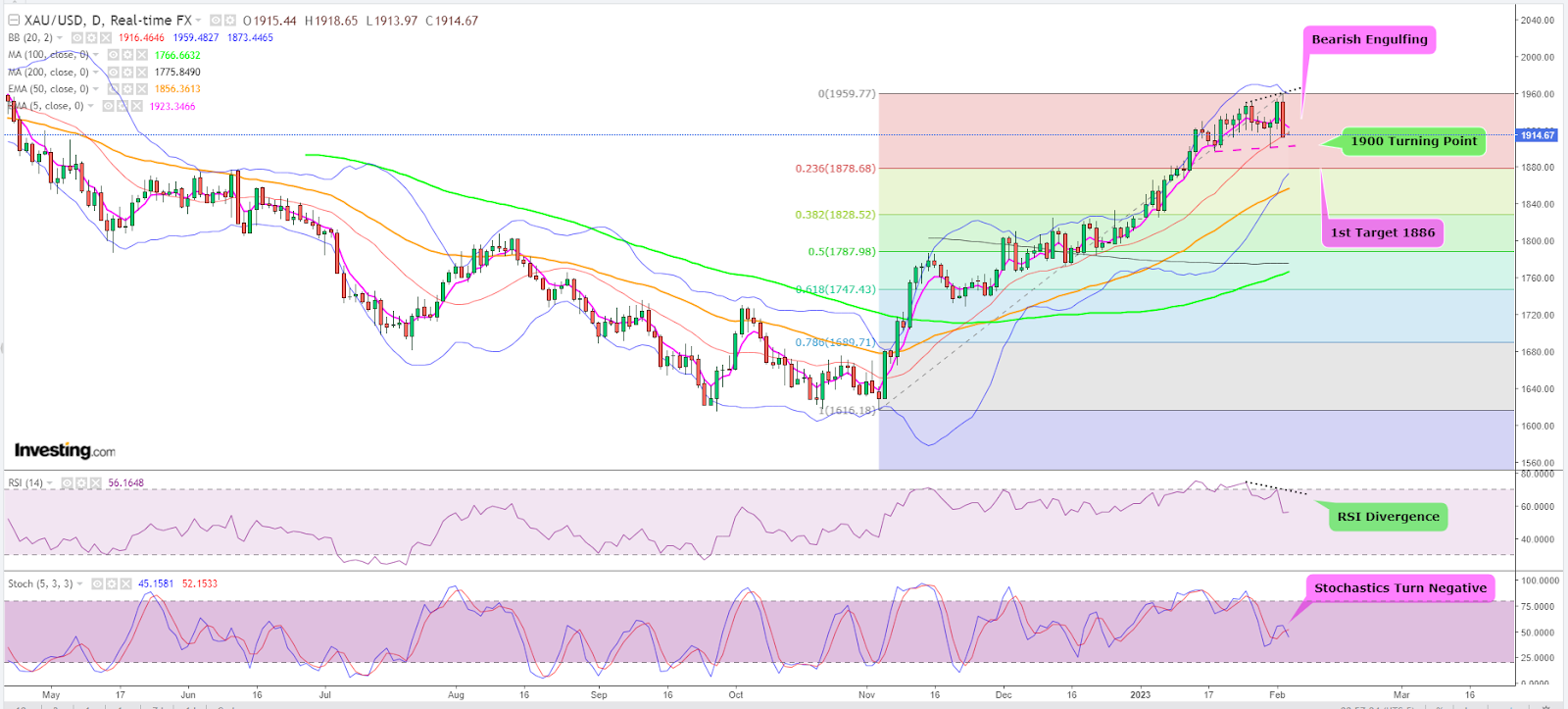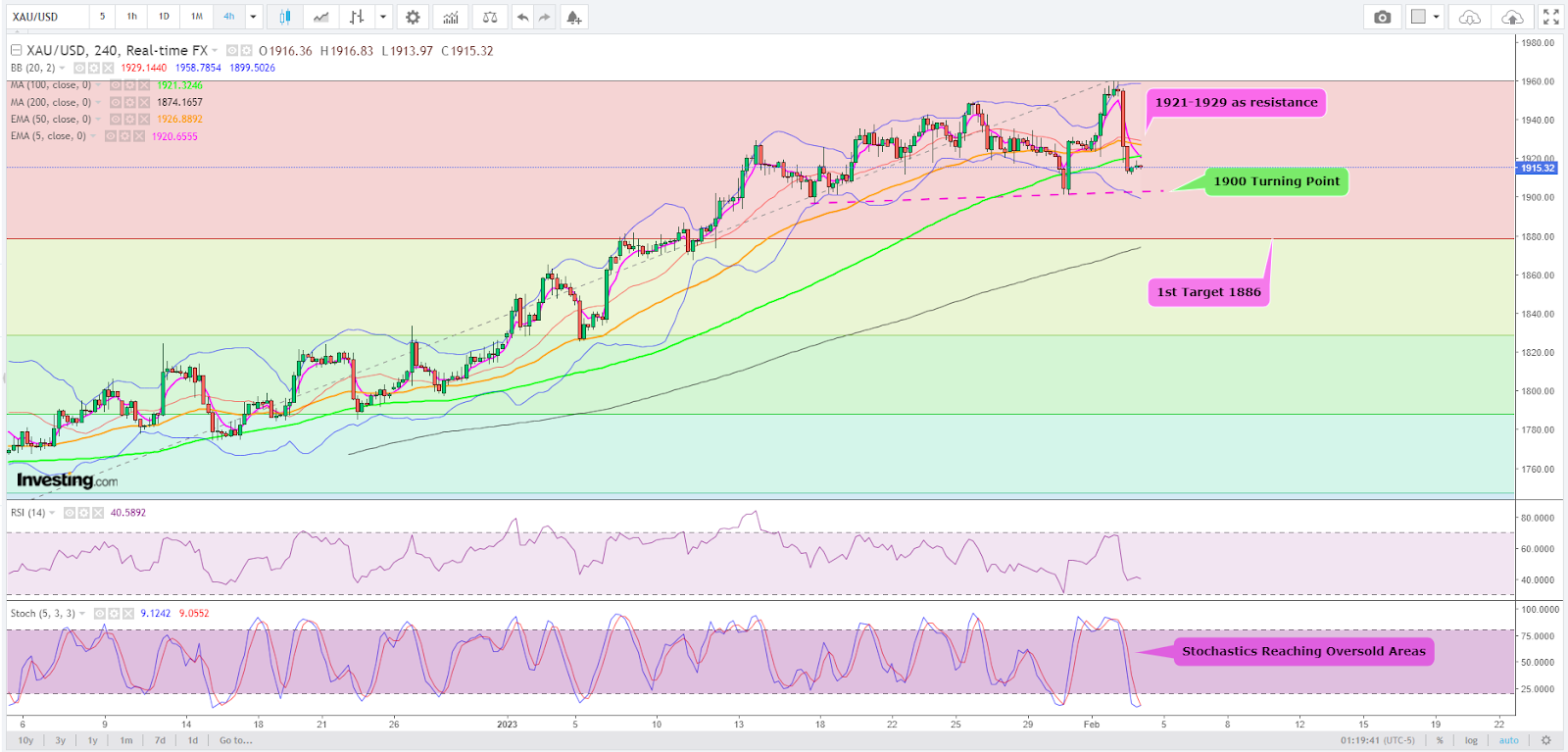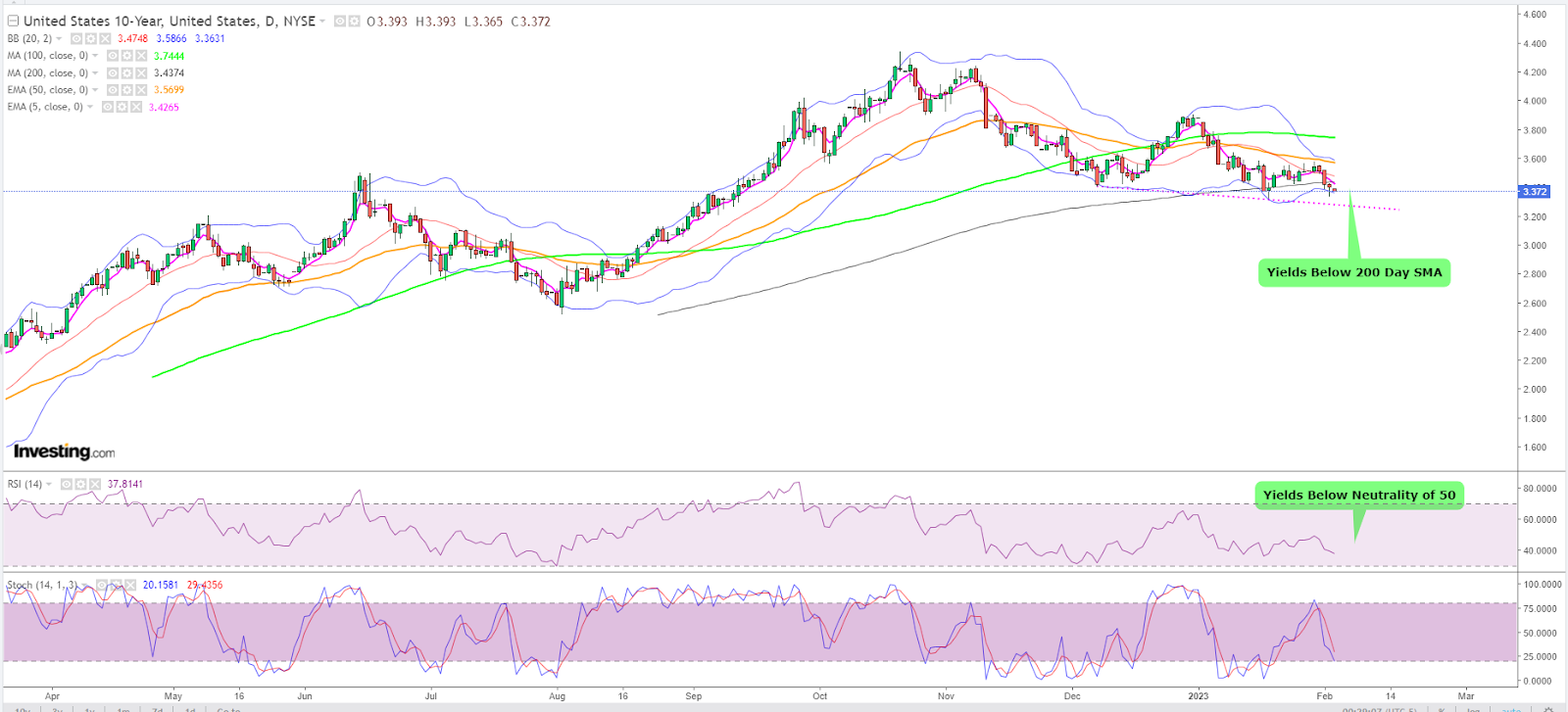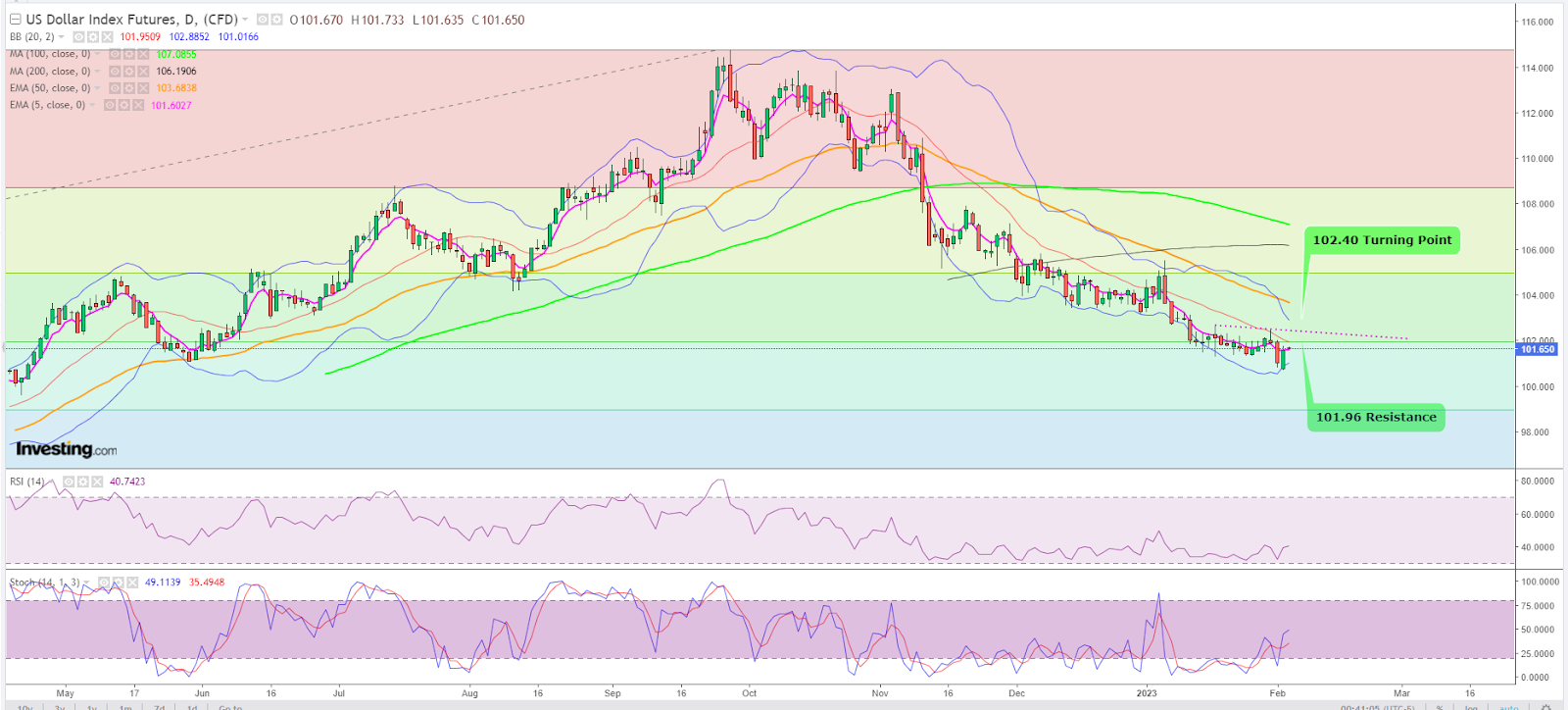- Gold futures reached a 9-month high of $1,975; spot gold at nearly $1,960
- A weaker-than-expected reading for nonfarm payrolls could help gold reach $2,000
- The Dollar Index is at a 10-month low of 100.68; further drop to 100.30 should aid gold
- Treasury yield, at a 2-week low of 3.333%, has room to drop to 3.28%, boosting gold
The Fed says it already sees disinflation. The central bank remains convinced there’ll be no U.S. recession this year though economists are adamant about one. The countervailing forces of the two positions make gold at least a hold, if not a buy. For bulls in the game, though, the ‘golden question’ — if you’ll forgive the cliche — is still: Are we getting to $2,000 from here?
Each time gold approaches or crosses $1,950, the world’s eyes seem glued on the yellow metal and whether it’ll have enough spring in its leap to pole vault over the 2K mark.
The feeling has been all too familiar since Jan. 24, when gold futures on New York’s COMEX hit $1,950 an ounce and peaked at a nine-month high above $1,975 in the latest session.
Bullion’s spot price, which typically moves slower than futures but is more closely followed by some traders, had its first $1,950 breach on Feb. 1, extending to almost $1,960 subsequently. Charts by SKCharting.com, with data powered by Investing.com
Charts by SKCharting.com, with data powered by Investing.com
At those highs, the gap for the two to reach the magic number was just $25 and $40, respectively. But intraday volatility from the Federal Reserve’s Feb. 1 rate decision and economic outlook cost gold, leaving the futures and spot price between $70 and $90 short of the 2K mark at the time of writing.
There is the risk, of course, that absent real economic stress, investors would have less urgency to pile into safe havens. That could turn gold on its head and result in a swift retreat toward the $1,900 support it had clung to since mid-January.
The last time gold ran above $2,000 was in April, when it virtually matched the August 2020 record high by getting to $2,078 on COMEX.
What Gold Needs to Do
In a blog that ran on FXStreet on Thursday, precious metals strategist Christian Borjon Valencia said spot gold had to remain above $1,900 at all costs.
“Otherwise, the yellow metal could extend its losses. A breach of $1,900 will expose the Jan. 18 low of $1,896.74, followed by the Jun. 13 high-turned-support at $1,879.45, ahead of the $1,850 psychological support.”
Ed Moya, an analyst at online trading platform OANDA, concurred:
“Gold seems poised to consolidate around the $1,900 level before it can make a run at the $2,000 level. Bullion traders will need to see disinflation trends to remain strong and for the labor market to soften for the bull case to remain in place.”
Sunil Kumar Dixit, Chief Technical Strategist at SKCharting.com, holds bullion to a higher bar.
“We need spot gold to close this week above $1,930 to reaffirm the uptrend that targets $1,972-$1,998 and beyond."
Dixit added that the RSI, or Relative Strength Index, divergence on the daily chart of bullion showed disagreement with rising prices, causing a temporary rebalancing and consolidation:
“On the flip side, oversold conditions on a 4-hour time frame can help gold buyers achieve break even when prices show some bounce back towards $1,921-$1,929, above which further recovery towards $1,932-$1,936 may be witnessed.”

U.S. Jobs Numbers
Other things need to happen, too, if gold is to advance to the 2K mark.
Among them are US jobs numbers for January, which need to come in meaningfully lower than expected to create some ding at least in employment and wage security, which the Fed suggests are its biggest two headaches in fighting inflation.
Ideally, no policymaker would wish ill on the nation’s labor market. The Fed isn’t doing that, of course, but it wishes for an easing of things that are a little “too good” now for the economy’s good — in this case, unemployment at more than 50-year lows and average monthly wages that have grown without stop since March 2021. Such job security and earnings have cushioned many Americans from the worst price pressures since the 1980s and encouraged them to continue spending, further feeding inflation.
“Although the pace of job gains has slowed over the past year and nominal wage growth has shown some signs of easing, the labor market continues to be out of balance,” said Fed Chair Jerome Powell after announcing a 25-basis point rate hike for February, the central bank’s smallest rate increase in a year.
The Fed has a particularly delicate job in trying to balance jobs with inflation. Both are top priorities for the central bank, which is mandated with ensuring “maximum employment” through a jobless rate of 4% or below and keeping inflation manageable. It did alright on the first and splendidly with the second for over a decade, when prices expanded at less than its target of 2% per annum.
Since the COVID-19 outbreak, the situation has reversed. The central bank has outperformed its jobs mandate as the labor market has grown by leaps and bounds since the pandemic. But it has done miserably in fighting inflation as trillions of dollars in COVID relief spending pumped up the economy. Inflation, as measured by the Consumer Price Index, hit four-decade highs in June when it expanded at 9.1% yearly. In December, it grew at 6.5% per annum, its slowest since October 2021. Yet, that was more than three times the Fed’s target.
Wall Street’s economists are expecting the so-called nonfarm payrolls report for January, due on Friday, to show a creation of 190,000 jobs versus the 223,000 in December.
Data-wise, the Labor Department revealed that jobless claims for the week ending on Jan. 28 fell to 183,000, some 3,000 three below last week’s 186,000 and well below the forecast 200,000. The data is evidence of labor market resilience.
Taken together with Wednesday’s JOLTs report that showed vacancies improving and an ISM report that stated that manufacturers “are not substantially” reducing their personnel, it suggests a jobs market still stronger than what the Fed likes.
These were among the reasons for gold’s return to below $1,950 in intraday trading over the past 24 hours. The retreat could deepen, or gold could break, depending on the nonfarm payrolls report.
The Dollar
The Dollar Index has lost more than 9% since September against the six currencies it is pitted against, reaching a 10-month low of 100.68 in the previous session.
The U.S. currency’s swoon has been a boon for gold instead, sending it to nine-month highs.
For gold to gain, the dollar has to ideally continue its decline, and this could be contingent on the nonfarm payrolls report.
Dixit analyzes:
“If the NFP numbers turn bad for the dollar, a staggering break below 101.30 may be followed by a decline towards 100.30. But in any case, if the dollar manages to make a sustained break above 101.96, it could be followed by a 102.45-102.65 horizontal resistance zone. A further up-leg will likely begin for 103.50.”
Treasury Yields
The dollar aside, U.S. bond yields are another contrarian indicator for gold’s ascent.
Yields on the 10-Year U.S. Treasury note fell to a two-week low of 3.333% on Thursday, hovering well below the 200-Day Simple Moving Average and threatening to further decline towards the descending trend line support at 3.28%, which is favored by an RSI below neutrality at 50.
Dixit said:
“If the NFP numbers come in stronger-than-indicated, they may cause a recovery in the 10-Year to test 3.5%. However, room for some more decline towards 3.28% is still intact.”

Disclaimer: Barani Krishnan uses a range of views outside his own to bring diversity to his analysis of any market. For neutrality, he sometimes presents contrarian views and market variables. He does not hold positions in the commodities and securities he writes about.

